Traditionally the art student would copy master drawings and then plaster casts of sculptures and monuments and then finally from life.
The Charles Bargue master drawings are a series of prints ranging from simple to more advanced drawing. Training the eye of the student to understand the effects of light and shadow, the illusion of form.
I totally support the point of view of French art teachers of the 19th century that fine art students need to study the rich traditions of the classical art.
French schools at that time advocated the following sequence of art education:- Drawing copies of classical art plates
- Copying drawings by the Old Masters
- Drawing classical casts - busts and figures
- Drawing live models
The 20th century brought various "isms" into art, and many art students become disillusioned with art education as it is practiced today.
Copying the Old Masters and studying their art is an important part of traditional art education. Copying classical masterpieces will develop a proper artistic taste and style. I believe that thousands of fine art students will improve greatly from such exercises.
These plates were created as a part of an intensive drawing course system designed by the late great draftsman, artist, and painter Charles Bargue
During my atelier training these lessons were integrated in the curriculum (as I'd imagine with most ateliers around the world) and taught as a means of refinement of observational skills in the practice of drawing.
Benefits are perpetual in the entire scope of the artist's development.
To have the ability to accurately record what the eye sees removing deviation or mental hindrance, I'd say is the basic principle behind this drawing system.
Once this is gained the artist is in a better position to integrate their imagination in a precision controlled manner.
Should you buy a copy of this book?If you're really serious about improving drawing skills, and you're willing to put in some hard hours of practice, then yes, you should definitely buy it.
If you just love drawing and have cash to burn, you should buy it.
If you're in the habit of buying art instruction books but you cant really draw that much, this book isn't going to magically help you draw better.
But neither is any art book.
Charles Bargue is mostly remembered for his "Cours de dessin", one of the most influential classical drawing courses conceived in collaboration with Jean-Lon Grme. The course, published between 1866 and 1871 by Goupil & Cie, comprised 197 lithographs printed as individual sheets, was to guide students from plaster casts to the study of great master drawings and finally to drawing from the living model.
The Charles Bargue Drawing Course is used by many academies and ateliers which focus on Classical Realism. Among the artists whose work is based on the study of Bargue's plate work are Pablo Picasso and Vincent van Gogh, who copied the complete set in 1880/1881, and (at least a part of it) again in 1890.
This book contains the plates from the original "Cours de dessin" digitally restored to more faithfully repesent the original plates as they appeared when new.
